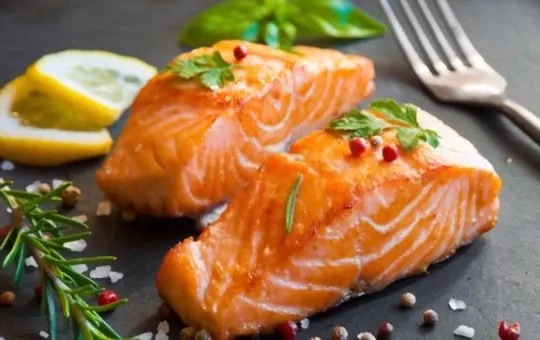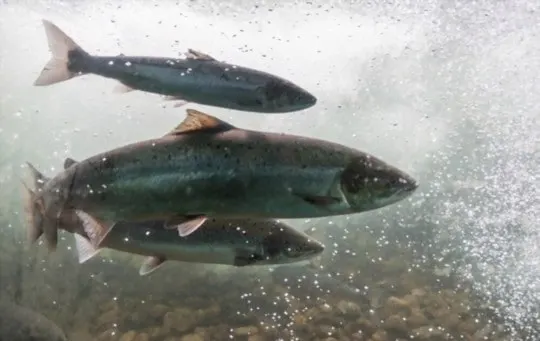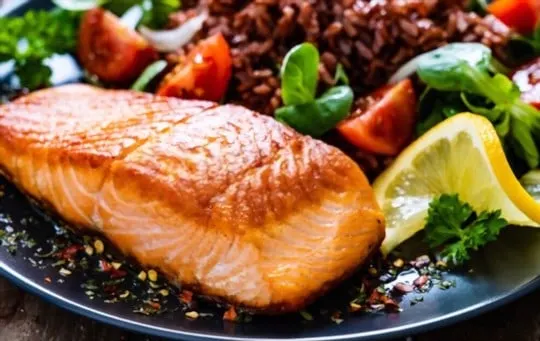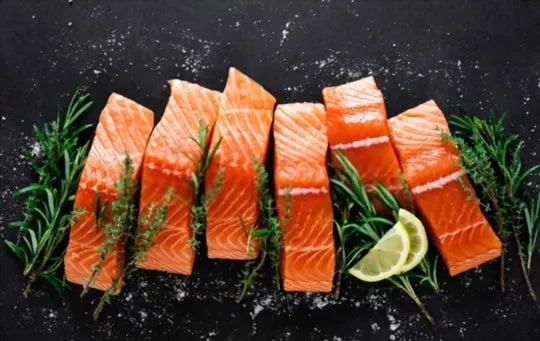Salmon is a type of fish that is consumed worldwide.
It has been found in the waters of many countries, such as Norway, Sweden, and Russia.
People eat salmon raw or cooked.
It’s considered one of the world’s healthiest foods because it contains Omega-3 fatty acids, which have many benefits to your body.
The flavor of salmon can vary depending on what type you are eating, what cooking method you use, and what sauces or spices you add while cooking.
In this blog post, we will go over what salmon is, cook it, and what salmon tastes like?
What is Salmon?

Salmon is a type of fish that belongs to the Salmonidae family.
Salmon live in saltwater and freshwater but usually visit the rivers to spawn or lay their eggs.
Salmon can grow up to 150cm long and weigh as much as 40kgs.
The coloration is influenced by diet; for example, those that feed on krill tend to be darker than those feeding on grass shrimp.
Salmon eat various foods, including krill, grass shrimp, and smaller fish such as herring or capelin.
Ocean-going salmon are usually anadromous (migratory) species that spawn in freshwater but live most of their lives at sea.
There are only one freshwater species on the West Coast of the United States.
There are various ways to prepare salmon, such as by smoking, frying, or grilling.
Nutritional Benefits of Salmon

Salmon is a great source of omega-3 fatty acids, which are an important component of brain health.
These fats also help to prevent heart disease and arthritis.
Salmon offers a good balance of protein to carbohydrates and has less saturated fat than red meat or chicken.
It’s also low in mercury compared to other fish like swordfish or tuna to be eaten without worry about toxic effects on the body.
Salmon is also high in vitamin D, which helps promote strong bones and ward off osteoporosis and B12 vitamins that keep the blood healthy by preventing anemia.
The benefits don’t stop there, though – salmon is rich in calcium for stronger teeth and bones, as well as iron for improved metabolism.
There are plenty of other health benefits too, and it tastes great too.
It’s rich in B vitamins, which are crucial for staying healthy, improving energy, preventing depression, and boosting immune function.
It’s also a good source of potassium, which helps to regulate blood pressure and heart health.
Salmon also contains astaxanthin, which is a powerful antioxidant that many people have used to treat arthritis.
Salmon is loaded with selenium, so it’s a great way to help your body naturally detoxify and balance hormones, making it easier for you to maintain a healthy weight.
So while it’s important to include a diverse variety of foods in your diet, salmon should be a regular part of that list.
Varieties of Salmon

Salmon, also known as the “king of fish,” is one of the most popular and versatile types of seafood.
There are six varieties: Chinook Salmon, Coho Salmon, Sockeye Salmon, Pink Salmon, Chum Salmon, and Atlantic salmon.
Each type of salmon has its distinct flavor and texture.
Chinook Salmon: The Chinook is a large, coho-like fish that can grow up to 100 pounds.
It has a dense flesh and savory flavor with a rich buttery texture.
It is the king of salmon and can be identified by its intense red hue.
Coho Salmon: Has an orange-red hue and is leaner than other varieties of salmon because they swim more actively through the water column, so less time on fatty lard deposits during their migrations.
Sockeye Salmon: Is the second most common variety in the U.S. and is characterized by its rosy flesh and small, dark spots.
Pink Salmon: Known by its pink hue thanks to the astaxanthin in krill that they feed on during migration up from the Gulf of Alaska, where it would normally be red due to carotenoids present in plankton found there.
Chum Salmon: Has a yellowish-orange hue and is the smallest variety of salmon, typically weighing in at about six pounds.
Atlantic Salmon: This is not actually from the Pacific Ocean but originates from Europe. They are very lean, with no hints of oil on their silky flesh that has an orange tint to it when cooked.
What Does Salmon Taste Like? Does Salmon Taste Good?

It’s not uncommon for people to be intimidated by salmon at first because it’s an expensive fish that can seem complicated.
However, this is one of the easiest and most delicious types of seafood you’ll ever taste.
Salmon has a light flavor with notes of buttery lemon in every bite.
Its texture ranges from flaky when cooked to moist when raw.
Cooked salmon is delicious when served with dill, capers, onions, garlic, and butter.
It can also be enjoyed as sushi or sashimi with soy sauce.
Raw salmon has the same texture as cooked salmon, but the flavor is less intense.
It’s best when served with a mix of soy sauce and wasabi for that extra zing.
The taste and texture of salmon are on the mild side, but it’s full-bodied and delicious.
Salmon can be expensive depending on where you buy it from, so if you’re looking to save some money, then try buying a frozen one.
The taste of salmon is lighter than tuna and some types of cod.
It doesn’t have the richness that other fish can have, but it has a buttery flavor that makes it unique.
It’s best to cook salmon in foil over coals or on a grill so that it gets crispy and doesn’t dry out.
Salmon tastes great on toast or in quinoa with avocado, spinach, parmesan cheese, and lemon juice.
Want to spice it up? Add some sriracha sauce or soy sauce.
How to Cook Salmon?

Shopping for your food is a great way to save money, but it’s also necessary to have the right ingredients on hand.
Thankfully, cooking salmon doesn’t take too much time or effort and can be done with just some salt, pepper, and butter.
All you need is:
- Salmon, either fresh or frozen (already iced).
- Salt and pepper to taste.
- Butter that has been melted in a pan. You can also use margarine if you prefer it over butter.
Before cooking the salmon filets, make sure they are thawed out first.
Anyone who cooks remembers what it’s like to start cooking ice-cold meat accidentally.
For the salmon filets to cook properly, you’ll want them thawed and iced in between a piece of foil or plastic wrap that has been sprayed with non-stick cooking spray.
This will prevent sticking and ensure they are fully cooked every time.
Unwrap your package of salmon and cut filets into portions that are about the size of your palm.
Next, you’ll want to generously cover these with salt and pepper on both sides before heating a skillet or pan over medium-high heat for three minutes.
Then place salmon in a heated pan, skin down (if it’s fresh) or top side up (if frozen), and cook for two minutes.
After cooking the salmon, it’s time to flip them over so they can finish cooking on their other side.
Then turn your heat down to medium-low and add a tablespoon of butter or margarine on top so that you can baste the fish while it cooks with its juices for five minutes.
The salmon is now finished cooking, so all that’s left to do is take it out and enjoy.
Be sure to remove the skin before eating.
You can eat this dish with a side of rice or vegetables for your home-cooked meal that will be ready in under 30 minutes.
How to Choose Salmon?

Some people have a hard time figuring out how to choose salmon.
They see all the different types and don’t know which is best for them.
Salmon can be found in several forms, like canned smoked or fresh fillets of fish.
You might also find it as pieces of steaks with bones attached, loins without bones, and steaks without bones.
Some people like to buy salmon when it’s fresh, while others prefer canned or smoked salmon.
If you are buying your fish at a grocery store, make sure the location is refrigerated so that you know they have been kept cold enough for bacteria not to grow on them.
If it isn’t refrigerated, ask a grocery store employee.
If you buy salmon at the seafood counter in your supermarket or specialty fish store, it will be fresh.
If they have refrigeration there, make sure to check it’s not too cold for you because this can also kill bacteria and lengthen shelf life.
When choosing smoked salmon from the case, first make sure that it is vacuum-packed.
Next, examine your salmon for color.
White to light pink colors are indicative of more freshness and flavor than darker or greenish hues.
The fillets of fish sold as a package in the grocery store typically have no bones because they were removed at processing time.
Fillets are easier to prepare for cooking.
However, if you want a more versatile product, you might prefer to buy salmon sold as steaks with the bones still attached.
Fresh fish often has less than one-half inch of fat covering its surface and should also have a shiny appearance.
Smoked or canned salmons will not be this way because they are cured before packaging.
How to Store Salmon?

There are several ways to store salmon, but the most popular methods include freezing or canning.
Some people choose not to freeze their fish because they believe that it is healthier without any preservatives, and this means if you’re eating locally sourced seafood, you won’t need to worry about how long your food will last.
However, there’s also the option of canning your fish, which is a great way to have salmon on hand for emergencies.
However, we all know that life doesn’t always go as planned, and if you find yourself in an emergency where you need food right away, then it’s best not to worry about how fresh or preservative-free your meal is.
Canning your fish is a great way to ensure that you’ll always have food, especially if there are any shortages of supplies or natural disasters on the horizon.
Freeze your fish if you’re not comfortable canning it, but make sure you know that it will last for about one year with no preservatives if you freeze your fish.
Conclusion
In conclusion, salmon is a great source of protein and omega-three fatty acids that can help protect us from cardiovascular disease.
In addition, salmon is a sustainable food source that can provide food security to the world.
The taste of salmon is very delicate.
Mild flavors make it a popular choice for people who don’t like their food too strong-tasting or spicy.
If you’re a fan of salmon, you’ll enjoy it whether grilled or smoked.

What Does Salmon Taste Like? Does Salmon Taste Good?
Ingredients
- Salmon
- Ingredients from your favorite recipes
Instructions
- Depending on the recipes you choose, the taste can vastly differ.
- For authentic results, it is important to choose a recipe that will highlight the original flavor.
- Have fun experimenting with different recipes and taste tests!
